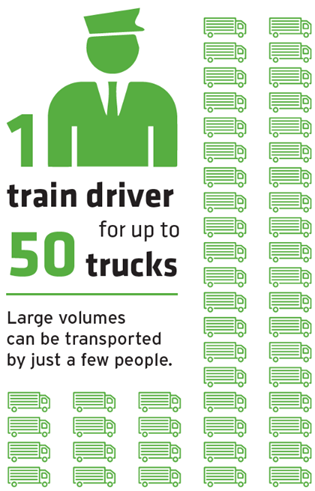Driver shortage

An intermodal freight train that may carry up to 50 truckloads requires a single (locomotive) driver to forward 50 long-distance trucks, which would otherwise require 50 long-distance truck drivers.
True, there will still be a need for 50 truck drivers to perform the first-mile road legs around the departure terminal, and another 50 truck drivers to take care of the last-mile road leg on the arrival end, but these are day-trucking jobs are much easier to fill since they offer greater variety and a more attractive work/life balance.
Intermodal truck drivers are easier to recruit and their pay is also somewhat more attractive as opposed to their long-distance counterparts’.
The European regulatory framework
Weights and Dimensions: The Weights and Dimensions Directive (https://eur-lex.europa.eu/legal-content/EN/AUTO/?uri=celex:31996L0053) sets maximum authorised dimensions of HDVs used in national and international commercial transport and the maximum authorised weights of HDVs used in international commercial transport. This ensures that Member States cannot restrict the circulation of vehicles, which comply with these limits from performing international transport operations within their territories.
These rules are complemented by the requirements for type-approval of commercial vehicles laid out in Directive 97/27/EC and its implementing measures, especially Regulations 661/2009 and 1230/2012 (https://eur-lex.europa.eu/legal-content/EN/AUTO/?uri=CELEX:32012R1230). These legal acts (under the responsibility of the Commission's DG GROW) set the framework for putting vehicles such as light-duty and heavy-duty vehicles, buses and trailers on the market.
Mobility Package: the European Commission’s Mobility Package of legislative proposals were unveiled in three parts:
- Mobility Package Part I: was published in May 2017 consisting of (i) posting rules for truck drivers, (ii) market rules for road hauliers, (iii) driving and rest time rules, (iv) Eurovignette Directive revision, (iv) tachograph rules, and (vi) guidelines and training materials for more efficient enforcement. (Further details here: https://transport.ec.europa.eu/transport-modes/road/mobility-package-i_en )
- Mobility Package Part II: was published in November 2017 consisting of (i) Combined Transport Directive revision, (ii) bus and coach market access rules, and (iii) the Clean Vehicles Directive.
- Mobility Package Part III: was published in May 2018 and was also referred to as the “road safety” package containing (i) new safety regulations for vehicles, (ii) extending safety requirements to more roads, (iii) new targets to halve road deaths and serious injuries by 2030, and (iv) the automated driving strategy.
Combined Transport Directive (92/106/EEC): Article 4 of the Combined Transport Directive deals with the road legs, stating:
“All hauliers established in a Member State who meet the conditions of access to the occupation and access to the market for transport of goods between Member States shall have the right to carry out, in the context of a combined transport operation between Member States, initial and/or final road haulage legs which form an integral part of the combined transport operation and which may or may not include the crossing of a frontier.”
Article 4 establishes the equivalence between cross-border road haulage within the European Single Market and its equivalent cross-border combined transport operation, hence it is also referred to as the “equivalence article”.
Eurovignette Directive (Road Tolling Directive 2022/362): the Eurovignette Directive has been recast as part of the Mobility Package into a Directive on “charging of vehicles for the use of certain infrastructures”, and it is now referred to the “road tolling directive” (https://eur-lex.europa.eu/legal-content/EN/TXT/PDF/?uri=CELEX:32022L0362). The Directive contains rules on (i) the conditions under which Member States can include road sections into the tolled network, (ii) guidelines for determining the tolls including the recovery of certain externalities, as well as (iii) exemptions, discounts and exclusions from tolling obligations. The imposition deadline of the Directive by Member States is 25 March 2024.
Country-specific rules
Suspension of compliance with CTD Article 4:
Regulation (EU) 2020/1055, part of the Mobility Package Part I, introduced a possibility for Member States to apply cabotage quotas to road legs of cross-border combined transport operations when the road legs do not cross a border. This can be seen as a form of derogation from the full application of Article 4 of the Combined Transport Directive.
“7. In addition to paragraphs 1 to 6 of this Article and by way of derogation from Article 4 of Directive 92/106/EEC, Member States may, where necessary to avoid misuse of the latter provision through the provision of unlimited and continuous services consisting in initial or final road legs within a host Member State that form part of combined transport operations between Member States, provide that Article 8 of this Regulation apply to hauliers when they carry out such initial and/or final road haulage legs within that Member State. With regard to such road haulage legs, Member States may provide for a longer period than the seven-day period provided for in Article 8(2) of this Regulation and may provide for a shorter period than the four-day period provided for in Article 8(2a) of this Regulation. The application of Article 8(4) of this Regulation to such transport operations shall be without prejudice to requirements following from Directive 92/106/EEC. Member States making use of the derogation provided for in this paragraph shall notify the Commission thereof before applying their relevant national measures. They shall review those measures at least every five years and shall notify the results of that review to the Commission. They shall make the rules, including the length of the respective periods, publicly available in a transparent manner.’“
Driving-ban exemptions
There is no European-level driving ban exemption in force in Europe, only on a national level. For instance, Germany grants truck performing Combined Transport road-legs an exemption from driving bans (for details see https://truckban.eu/Germany), while partial, terminal-specific localised exemptions apply in Austria (https://truckban.eu/Austria).

Akos Ersek
Chief Policy Advisor



